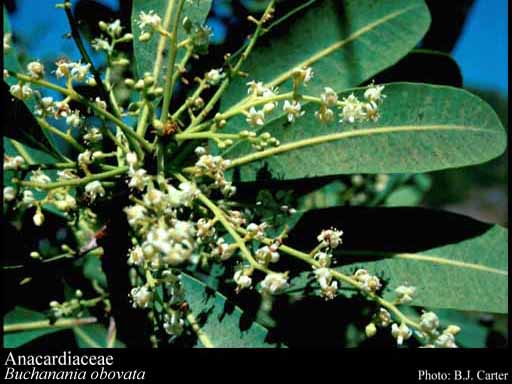- Reference
- J.H.Tuckey, Narr.Exped.Zaire 431 (1818)
- Name Status
- Current

Scientific Description
Common name. Sumac Family.
Habit and leaf form. Trees, or shrubs; evergreen, or deciduous; laticiferous (e.g. in Anacardium), or non-laticiferous and without coloured juice; resinous. Self supporting, or climbing. Leaves nearly always alternate (opposite in Bouea); when alternate, spiral; ‘herbaceous’; aromatic (resinous), or without marked odour; simple, or compound; when compound, ternate, or pinnate. Leaf blades pinnately veined. Leaves without stipules. Leaf blade margins entire. Domatia recorded (in 8 genera); represented by pits, or pockets, or hair tufts. Stem anatomy. Nodes tri-lacunar. Secondary thickening developing from a conventional cambial ring.
Reproductive type, pollination. Fertile flowers hermaphrodite, or functionally male and functionally female, or functionally male, or functionally female, or hermaphrodite, functionally male, and functionally female. Unisexual flowers present, or absent. Plants hermaphrodite, or monoecious, or dioecious, or gynodioecious, or polygamomonoecious.
Inflorescence and flower features. Flowers aggregated in ‘inflorescences’; in panicles. The terminal inflorescence unit racemose. Flowers regular; typically 5 merous; cyclic; tetracyclic, or pentacyclic. Free hypanthium present (short), or absent. Hypogynous disk present; intrastaminal; annular. Perianth with distinct calyx and corolla, or sepaline; 3–5, or 6–10; 1 -whorled, or 2 -whorled; isomerous. Calyx 3–5; 1 -whorled; basally gamosepalous; entire, or lobed; imbricate; regular. Corolla when present, 3–5; 1 -whorled; polypetalous, or gamopetalous (rarely, basally); imbricate. Fertile stamens present, or absent (in females). Androecium 5–10(–12). Androecial members free of the perianth; all equal, or markedly unequal; free of one another, or coherent; when coherent 1 - adelphous (the filaments sometimes basally connate); 1 -whorled, or 2 -whorled. Androecium exclusively of fertile stamens, or including staminodes. Staminodes when present, 1–9. Stamens (1–)5–10(–12); oppositisepalous. Anthers dorsifixed (mostly), or basifixed (e.g. Spondias); versatile; dehiscing via longitudinal slits; introrse; tetrasporangiate. Pollen shed as single grains. Fertile gynoecium present, or absent (from male flowers). Gynoecium 1–3–5 carpelled. The pistil 1–5 celled. Gynoecium syncarpous; semicarpous, or synovarious, or synstylovarious; superior (usually), or partly inferior. Ovary unilocular, or plurilocular; 1–5 locular. Styles 1 (usually), or 1–5 (sometimes with supernumerary styles from sterile carpels). Stigmas 1–5; wet type; non-papillate; Group IV type. Placentation when unilocular parietal, or basal; when bi- or plurilocular basal. Ovules in the single cavity when unilocular, 1; 1 per locule; pendulous, or ascending; apotropous; with ventral raphe (when erect, the micropyle inferior), or with dorsal raphe (when pendulous, the micropyle superior); non-arillate; anatropous.
Fruit and seed features. Fruit fleshy (usually), or non-fleshy (occasionally); when dry indehiscent; a drupe. Seeds non-endospermic. Cotyledons 2. Embryo chlorophyllous (4/4), or achlorophyllous (2/2); curved. Seedling. Germination phanerocotylar, or cryptocotylar.
Physiology, biochemistry. Aluminium accumulation not found. Photosynthetic pathway: C3.
Geography, cytology, number of species. World distribution: widespread in the tropics, also Mediterranean, E. Asia, America. X = 7–16. 600 species.
Economic uses, etc. Including commercially important fruits — cashew-nut (Anacardium, and the fleshy peduncle, ‘cashew-apple’), mango (Mangifera), Jamaica plum, hog-plum, imbu (Spondias). Resins, oils and lacquers from Toxicodendron.